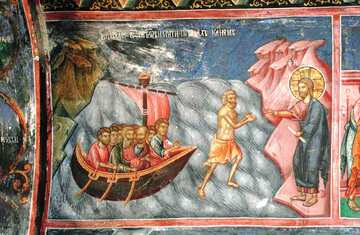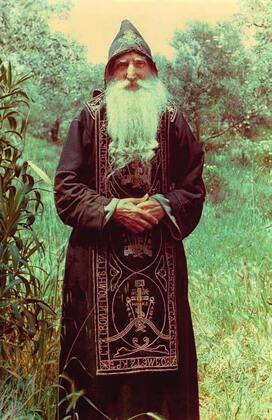 In the 9th Sunday after Pentecost, we heard the Gospel reading in which our Lord walks on water and calms the storm. This reading shows us an image of Who our Lord really is and what He came to bring us. The entire Gospel is a walking on water. It transcends this world. It is above our nature, if we fulfill it. The nature of the Gospel is not of this world. The true Christian is not of this world, as our Lord says many times: “If you were of the world, the world would love its own. But that’s why the world hates you. Just as I am not of this world, likewise you are not of this world” (cf. John 15.19). It is good to be aware of these things. Many times, we try to conform too much to the world and we get lost, we melt, we lose heart. “But if the salt loses its flavor, how will you season it?” (Mark 9.50).
In the 9th Sunday after Pentecost, we heard the Gospel reading in which our Lord walks on water and calms the storm. This reading shows us an image of Who our Lord really is and what He came to bring us. The entire Gospel is a walking on water. It transcends this world. It is above our nature, if we fulfill it. The nature of the Gospel is not of this world. The true Christian is not of this world, as our Lord says many times: “If you were of the world, the world would love its own. But that’s why the world hates you. Just as I am not of this world, likewise you are not of this world” (cf. John 15.19). It is good to be aware of these things. Many times, we try to conform too much to the world and we get lost, we melt, we lose heart. “But if the salt loses its flavor, how will you season it?” (Mark 9.50).
Neither the Gospel nor the Christian are of this world. Yet the most appropriate image is exactly this walking on water. That’s how the Gospel stands, and that’s how we are too, like Saint Peter who, upon seeing our Lord walk on water, also wanted to do the same. And he succeeds at Christ’s invitation. We also set foot on this water, we believed it was possible, yet we see it’s a bit difficult and we’re underwater more often than not, but we still don’t give up. We still believe that we can walk on water like our Lord.
And I like questions like the one that appears in today’s Epistle: “Do you not know that you are the temple of God and that the Spirit of God dwells in you?” (1 Corinthians 3.16). Because the Corinthians, like us, were overwhelmed by many chores, worries, exhaustion, passions, enmities, and suddenly they hear this: “Do you not know that you are the temple of God and that the Spirit of God dwells in you?” This is what our Lord asks us, too: “Do you not know that you can walk on water?!”
This is how our Lord is. His walking on land is a concession, because it’s when He walks on water that He shows us Who He truly is. Even when He endures His Cross, He walks on water, because he doesn’t endure it like we would, nor like how He is represented in Catholic art, totally exhausted. No, he endured it with peace. He tells the Apostles: “Let not your heart be troubled!” (John 14.1), because His heart was not troubled when He endured the Cross. He didn’t sink. He walked on water even while on the Cross. He always walks on water. That is why we should always look upon Him.
 The Divine Liturgy is like this par excellence. Father Aimilianos of Simonopetra, who reached spiritual perfection, when he interprets the divine services, says that our Lord is everywhere:
The Divine Liturgy is like this par excellence. Father Aimilianos of Simonopetra, who reached spiritual perfection, when he interprets the divine services, says that our Lord is everywhere:
“Everything we see here in the church – the chandeliers, the priest, the Holy Table, the Gospel book, the Precious Gifts, the Little and Great Entrance – all of these become signs of Christ’s presence… Through the Divine Liturgy, we continue the work of Christ and, whenever we serve it, it’s as if we attract Christ Himself, drawing Him close to us… If we have spiritual eyes, we can sense that before us stands Christ Himself. What do you do when, from where you are, you see someone you love? You run to him. The Liturgy is a movement, a sprint, an endeavor to capture Christ, to take hold of Him.”
 Therefore, we can develop the Apostle Paul’s question: “Do you not know that Christ is here, in the Divine Liturgy?!” It’s with this sense that we should approach and live the Liturgy. Father Aimilianos also gives the example of a contemporary saint from the Holy Mountain, Papa Tikhon, who usually served alone (as priest), with a disciple whom he told: “Go outside, go, go quickly!”, closing the door and remaining alone in the sanctuary, where he would stay for an hour or two. Afterwards, after his spirit bathed in the divine light and his eyes beheld God’s radiance, he would open the church door and tell his disciple: “Come on, enter! The Holy Spirit was here, over there the seraphim, the cherubim trembling all over yet full of joy and gratitude.” Or as Father Arsenie Papacioc would say: “During the Liturgy, there is not more in heaven than there is in the Holy Sanctuary.”
Therefore, we can develop the Apostle Paul’s question: “Do you not know that Christ is here, in the Divine Liturgy?!” It’s with this sense that we should approach and live the Liturgy. Father Aimilianos also gives the example of a contemporary saint from the Holy Mountain, Papa Tikhon, who usually served alone (as priest), with a disciple whom he told: “Go outside, go, go quickly!”, closing the door and remaining alone in the sanctuary, where he would stay for an hour or two. Afterwards, after his spirit bathed in the divine light and his eyes beheld God’s radiance, he would open the church door and tell his disciple: “Come on, enter! The Holy Spirit was here, over there the seraphim, the cherubim trembling all over yet full of joy and gratitude.” Or as Father Arsenie Papacioc would say: “During the Liturgy, there is not more in heaven than there is in the Holy Sanctuary.”
There are spiritual realities. For us, it’s enough if we sense that we stand before our Lord, Who is present. That’s why He keeps asking us, “Do you not know that you can walk on water, or that I’m with you?” He asks us to awaken us from our distresses. We are so deep under water, that we need to wake up, because God didn’t make us to drown, to slip under the waves. This is the true man, this is the dignity with which He created us: not to be overwhelmed by the times, but to be above the times. This is today’s beautiful image of our Lord walking on water. And every time we attend Liturgy, we also walk above the water, we lift ourselves up a bit.
We should attempt this in our personal prayer, too. Saint Basil the Great says that if you didn’t concentrate at prayer, at least be aware that you are standing before the King. This is the most important thing. We aren’t saying lofty things about the mind descending into the heart, but rather about this awareness that God is present, He awaits our prayer and receives it. Even if it’s scattered or weak, at least we mumbled something before our Lord. And He receives it as any parent appreciates everything his/her child makes, even if it has no objective value, but for the parent it has great value because his/her child made it. We need this awareness. It doesn’t matter that you’re a sinful mess, but it matters that you know that you belong to God and you stand before Him. This awakens and heals us. God created us to stand before Him. He will teach us to stand on top of the water. You may no longer believe that there is light at the end of the tunnel, but He can make it appear. The fact that you are alive shows that God believes in you. Let Him work. How exactly? By standing before Him, however I may be. Of course, I won’t parade around my mess. I am sinful and humble, but I’m aware that I stand before my Lord. And He has the power to heal me just as He can walk on water.
The image of our Lord walking on water reveals just how much He can achieve with and within us. We need to learn to stand before Him and to let Him heal our hearts, to let Him teach us to walk on water.
We’ll close with an example. I heard recently of a priest in a large city in Romania, who serves at a chapel in a medical institute. This priest serves three or four series of 40 daily Liturgies every year, and he has many other beautiful customs. One day, the director of the medical institute approached this priest to inform him that he would close the chapel and convert it into a waiting room. The priest said nothing, but proposed to his community that everyone start reading from the Psalter. After three days, the director to the priest on his knees, begging forgiveness. In the meantime, several people close to him had died and he realized that his decision to close the chapel was the reason. He asked forgiveness and said that as long as he is director, the priest would not have any problems. Behold, as Saint Paul says, “Do you not know the power that your prayers have?” This priest reveals this to us. I saw this at Putna Monastery, too. If our Father Abbot told the brotherhood to pray for a certain problem, it was resolved quickly. That’s the level of faith there. For any problem, there was recourse to prayer and it was resolved.
“Do you not know…?!”
